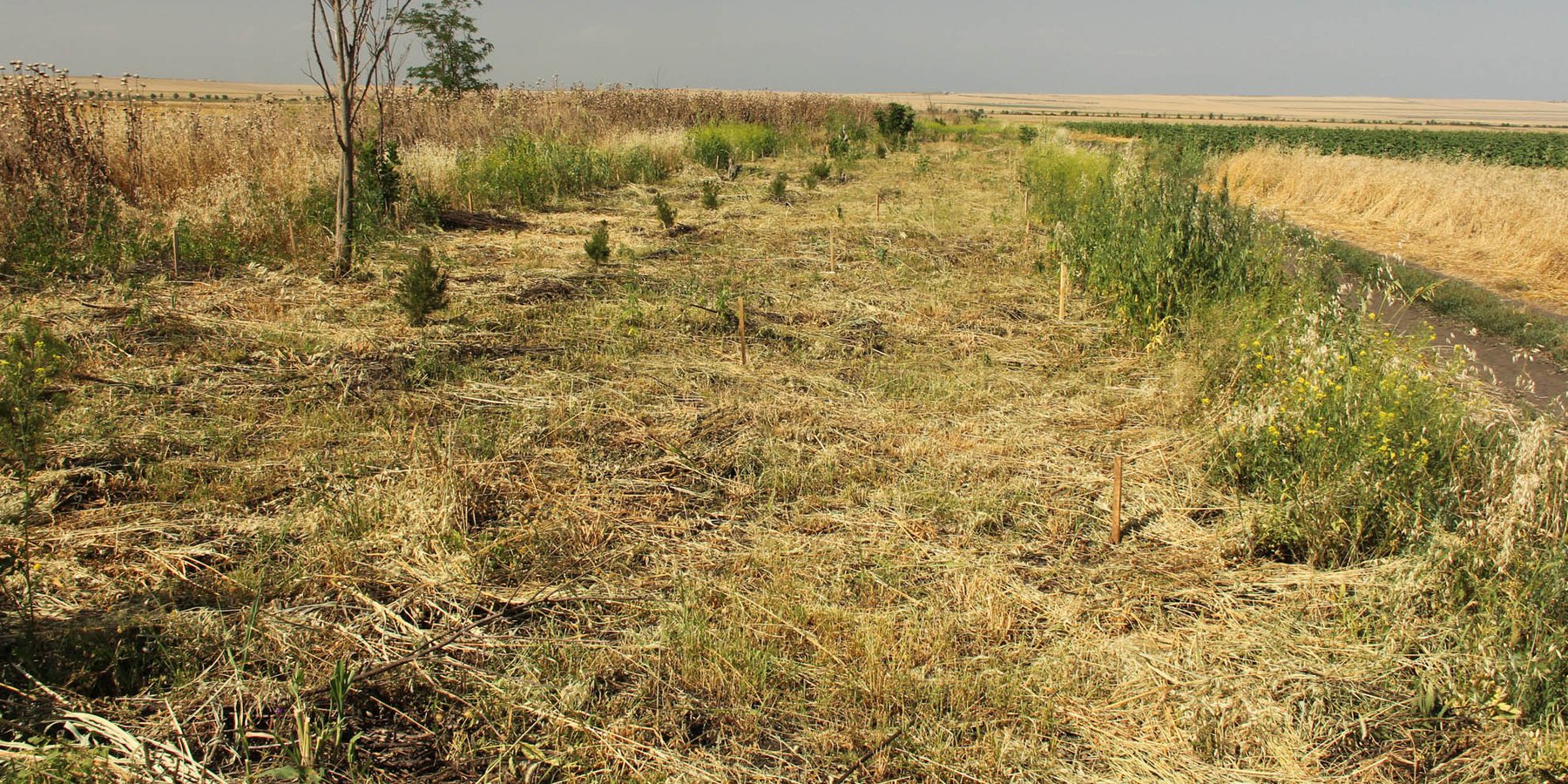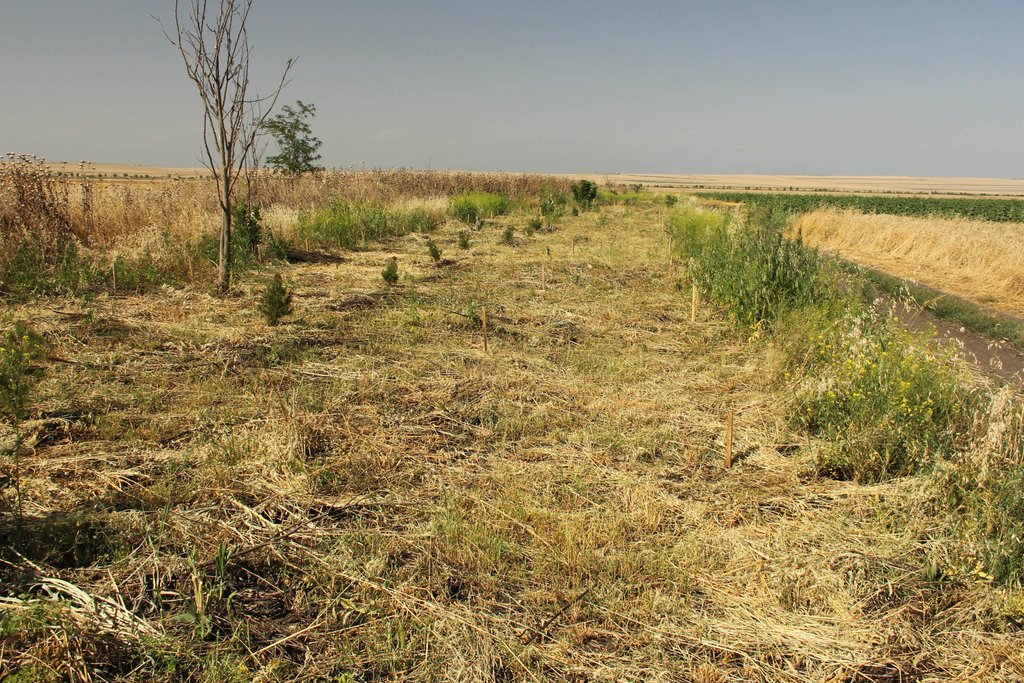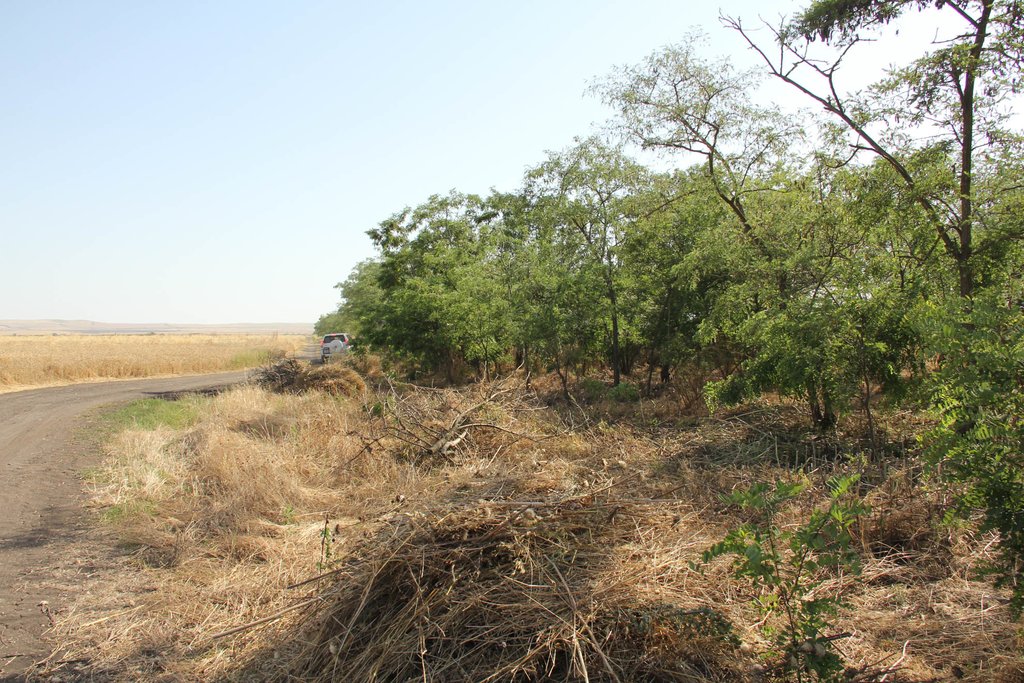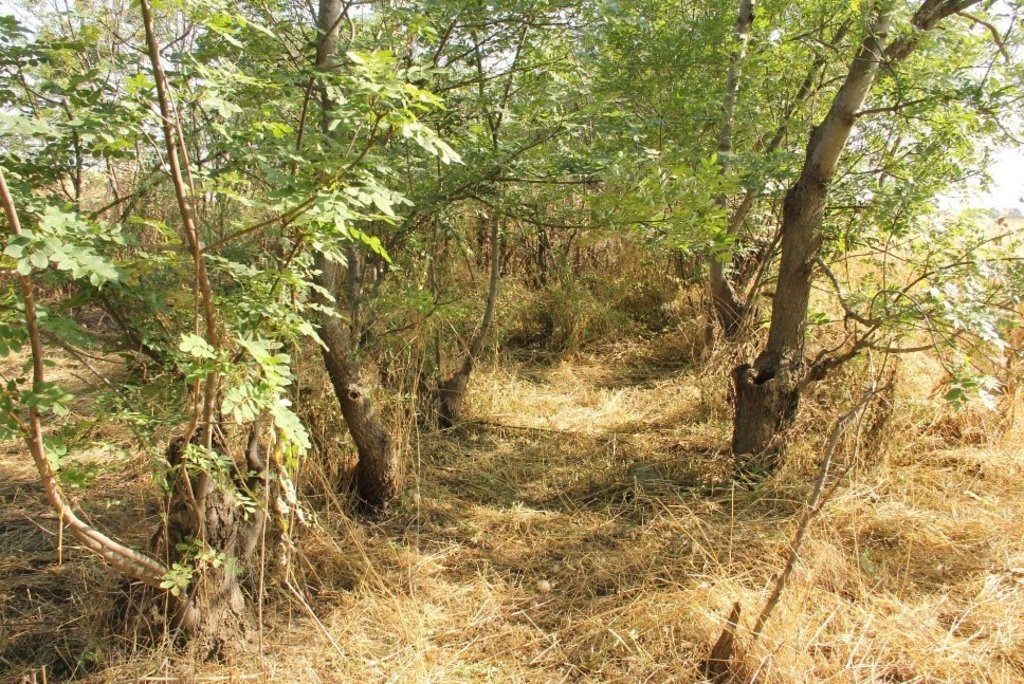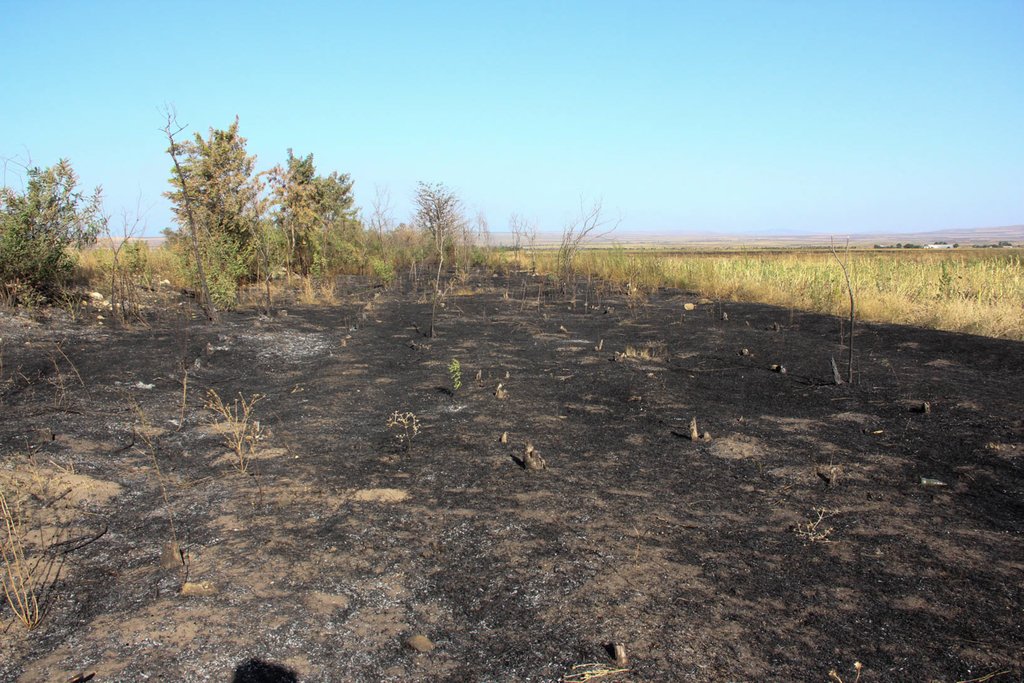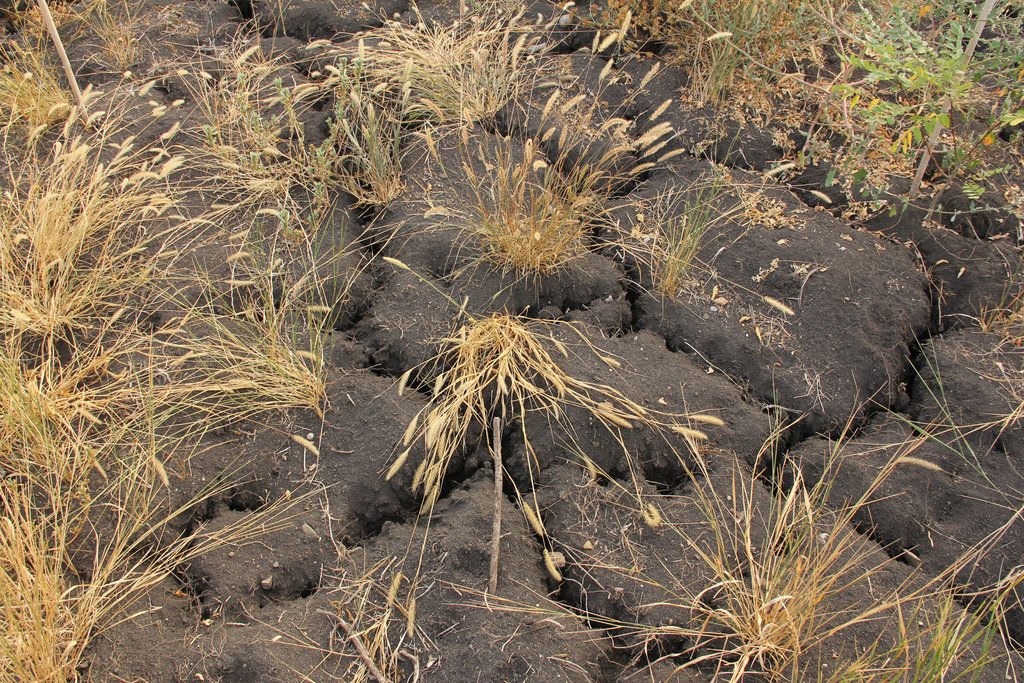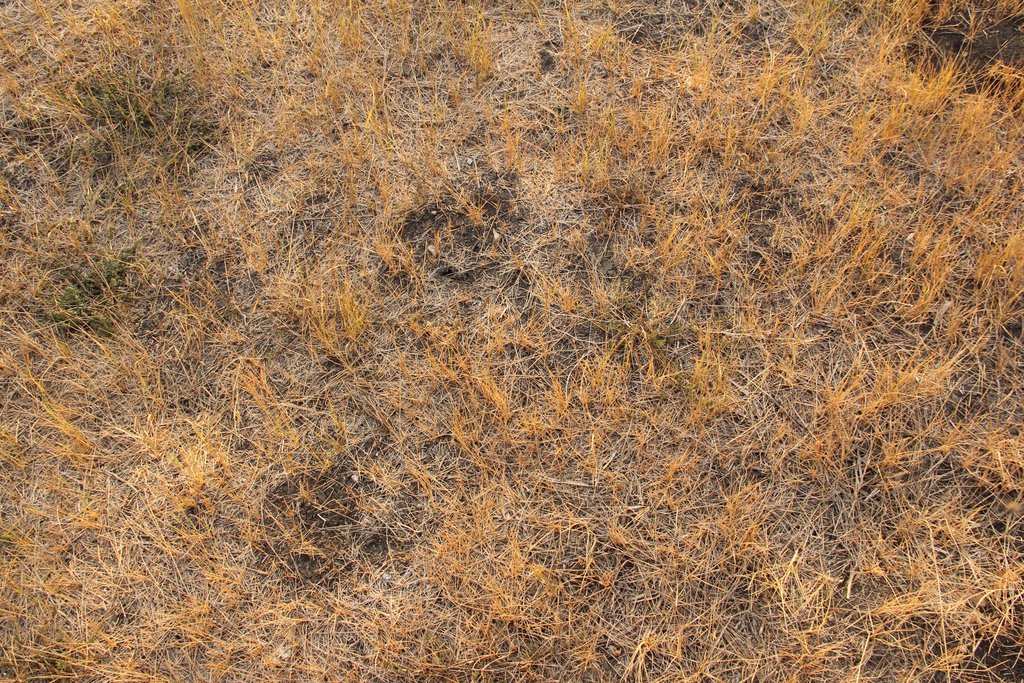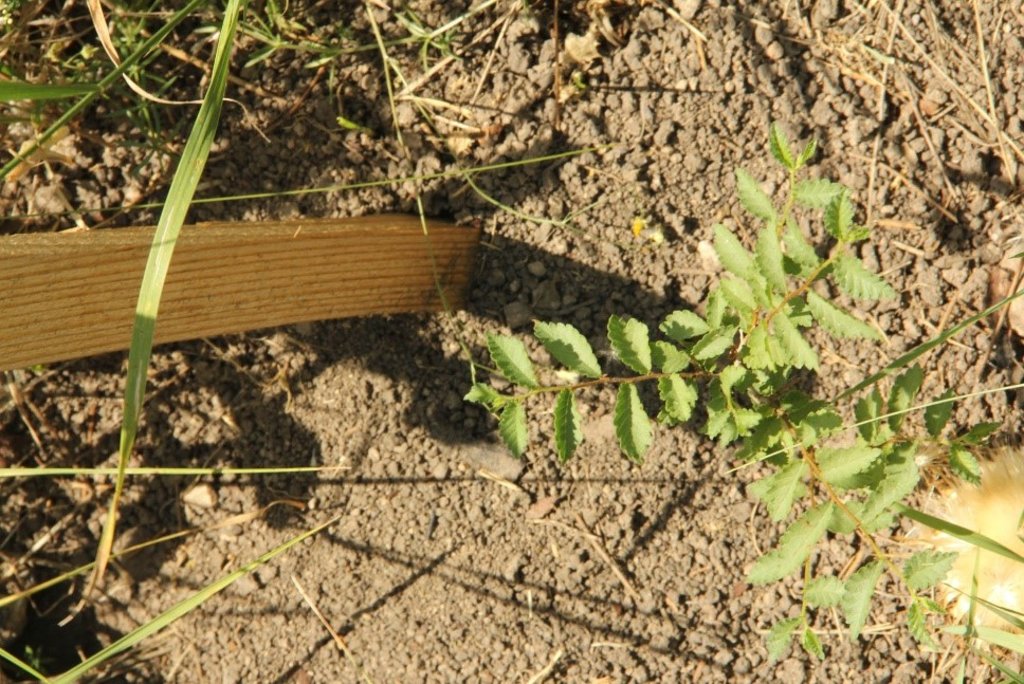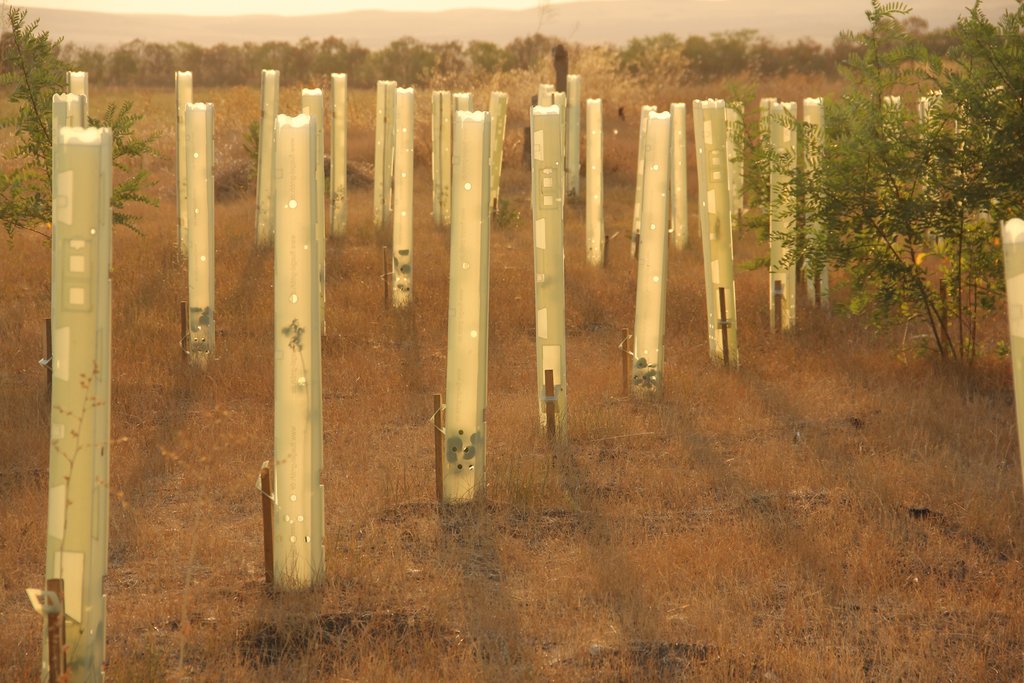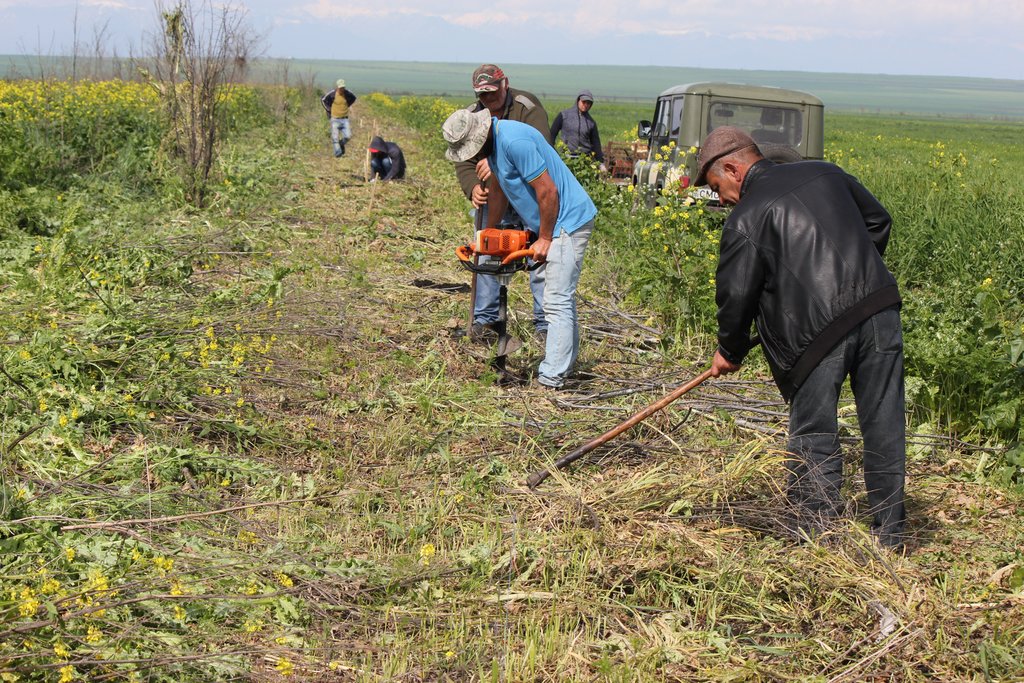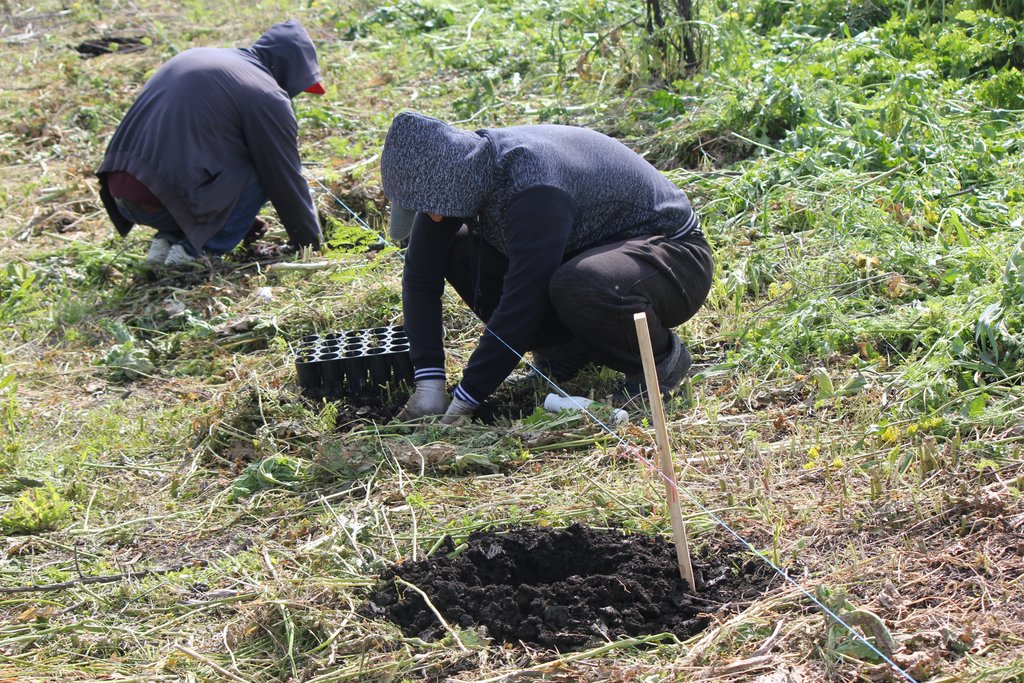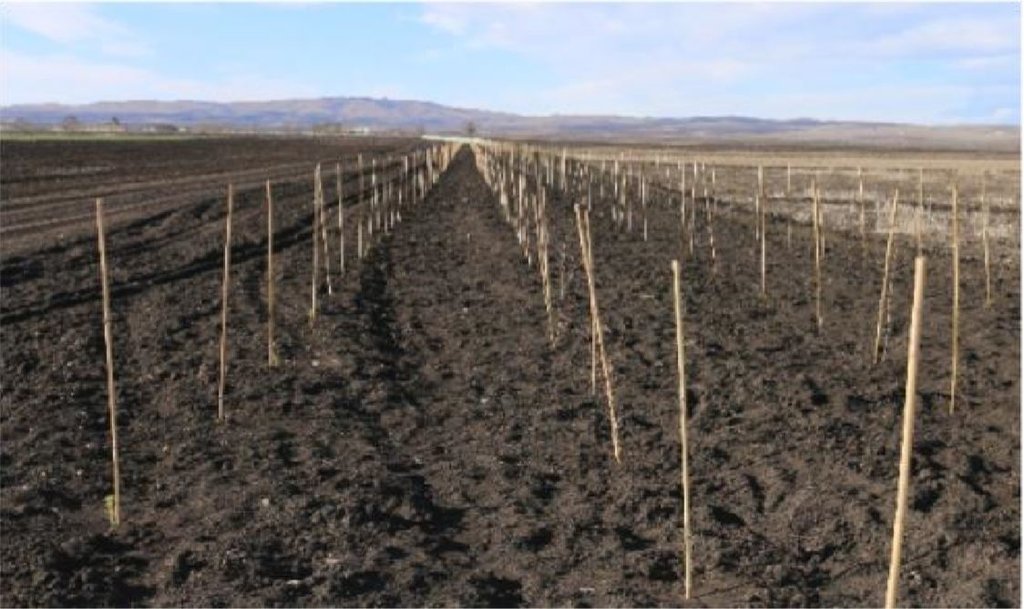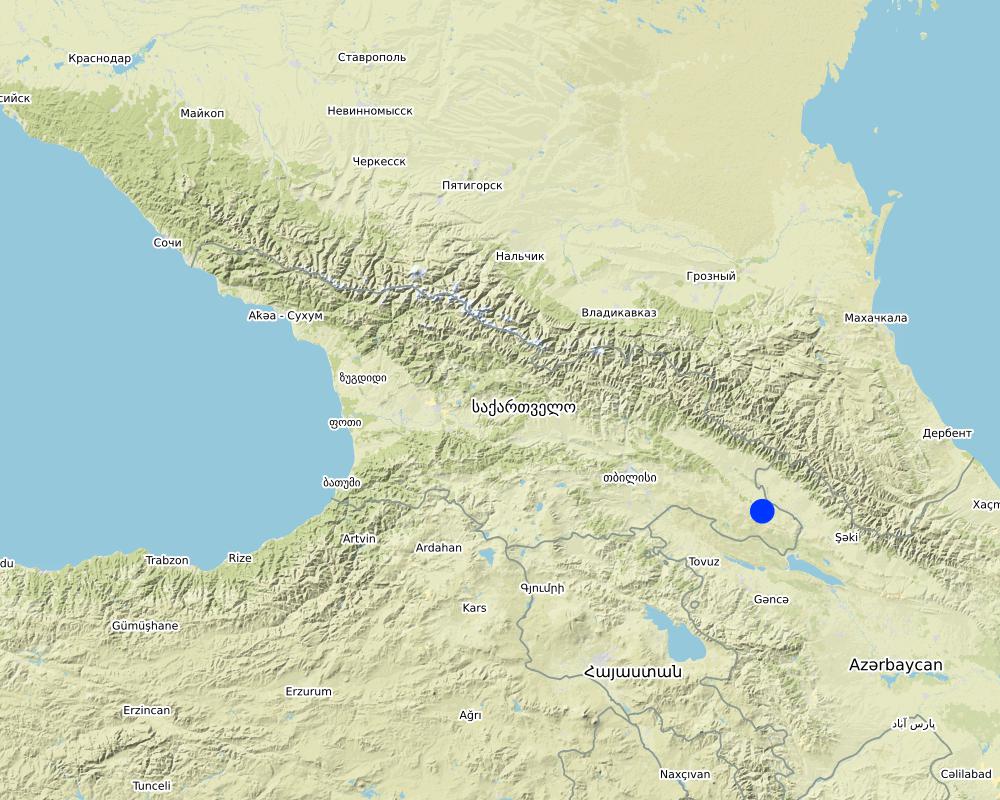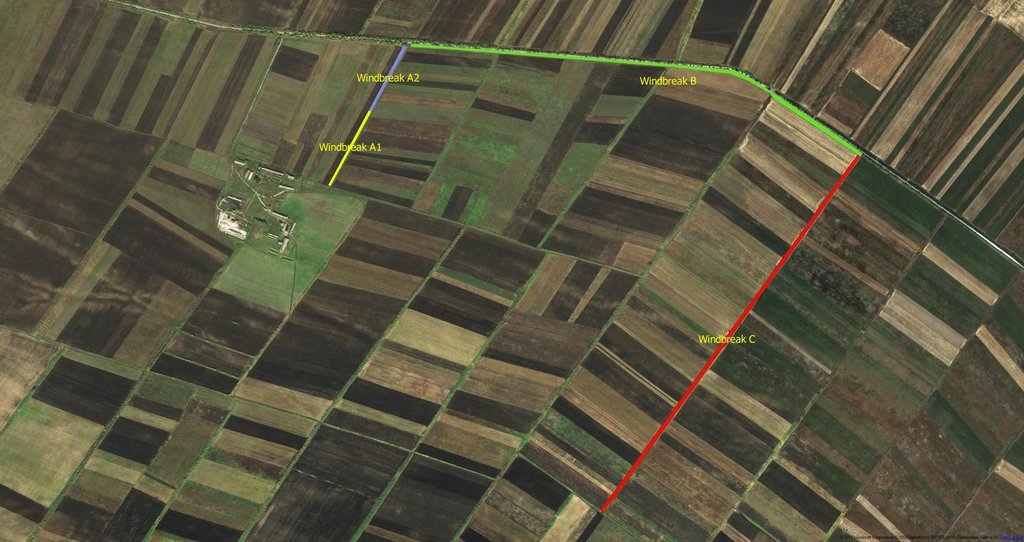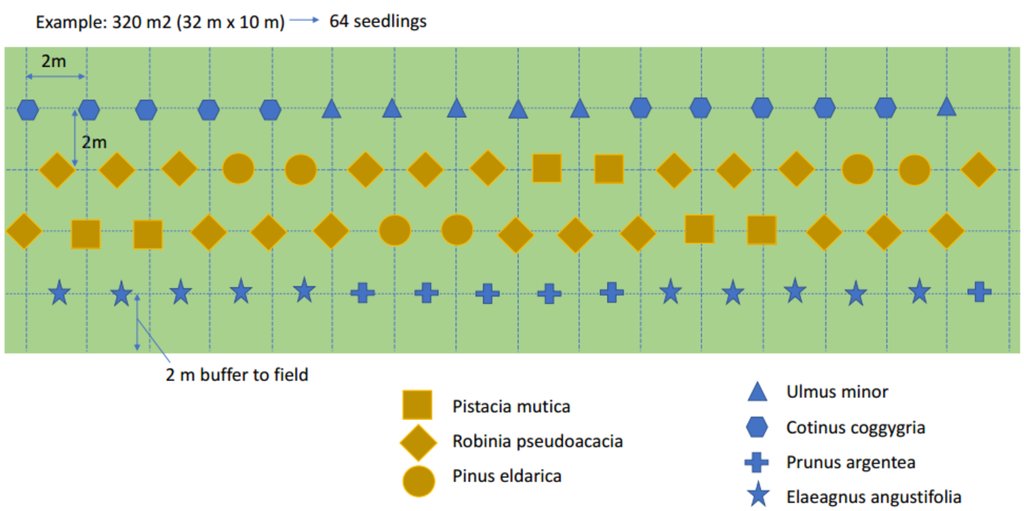Rehabilitation of Windbreaks [จอร์เจีย]
- ผู้สร้างสรรค์:
- การอัพเดท:
- ผู้รวบรวม: Hanns Kirchmeir
- ผู้เรียบเรียง: Kety Tsereteli
- ผู้ตรวจสอบ: Rima Mekdaschi Studer
technologies_4274 - จอร์เจีย
ดูส่วนย่อย
ขยายทั้งหมด ย่อทั้งหมด1. ข้อมูลทั่วไป
1.2 รายละเอียดที่ติดต่อได้ของผู้รวบรวมและองค์กรที่เกี่ยวข้องในการประเมินและการจัดเตรียมทำเอกสารของเทคโนโลยี
co-compiler:
co-compiler:
co-compiler:
ชื่อของโครงการซึ่งอำนวยความสะดวกในการทำเอกสารหรือการประเมินเทคโนโลยี (ถ้าเกี่ยวข้อง)
Applying Landscape and Sustainable Land Management (L-SLM) for mitigating land degradation and contributing to poverty reduction in rural area (L-SLM Project)ชื่อขององค์กรซึ่งอำนวยความสะดวกในการทำเอกสารหรือการประเมินเทคโนโลยี (ถ้าเกี่ยวข้อง)
Regional Environmental Centre for the Caucasus (REC Caucasus) - จอร์เจียชื่อขององค์กรซึ่งอำนวยความสะดวกในการทำเอกสารหรือการประเมินเทคโนโลยี (ถ้าเกี่ยวข้อง)
Deutsche Gesellschaft für Internationale Zusammenarbeit (GIZ)1.3 เงื่อนไขการใช้ข้อมูลที่ได้บันทึกผ่านทาง WOCAT
ผู้รวบรวมและวิทยากรหลักยอมรับเงื่อนไขเกี่ยวกับการใช้ข้อมูลที่ถูกบันทึกผ่านทาง WOCAT:
ใช่
1.4 การเปิดเผยเรื่องความยั่งยืนของเทคโนโลยีที่ได้อธิบายไว้
เทคโนโลยีที่ได้อธิบายไว้นี้เป็นปัญหาของความเสื่อมโทรมโทรมของที่ดินหรือไม่ จึงไม่ได้รับการยอมรับว่าเป็นเทคโนโลยีเพื่อการจัดการที่ดินอย่างยั่งยืน:
ไม่ใช่
2. การอธิบายลักษณะของเทคโนโลยี SLM
2.1 การอธิบายแบบสั้น ๆ ของเทคโนโลยี
คำจำกัดความของเทคโนโลยี:
Windbreaks are an integrated technology to increase land productivity and biodiversity at different levels. Along six kilometres, located between a road and agricultural fields, windbreaks were rehabilitated or newly established to protect the soil wind erosion. Four lines of seedlings including seven tree species were planted in two meters distance to each other. The survival rates of different tree species have been accessed and evaluated.
2.2 การอธิบายแบบละเอียดของเทคโนโลยี
คำอธิบาย:
Agriculture plays a key role in the economy of Georgia. 74% of wheat is produced in Kakheti. Within the region, the main wheat-growing area is Shiraki valley located in Dedoplistskaro Municipality in Eastern Georgia. The valley has deep soil with high humus content offering significant potential for high agricultural yields. Among others, wind erosion and increase of evaporation due to degradation of windbreaks have led to reduced agricultural yields. At the end of the Soviet Union, there were 1.800 km of tree windbreaks in Shiraki. More than 90% of them were destroyed either by fire or illegal cuttings for firewood. Fires are caused by farmers burning harvest residues and by shepherds burning pastures and windbreaks to facilitate the growth of new grass and clear land. Today, fire still pose the greatest threat to the rehabilitation of windbreaks. Grazing by migrating sheep and by local (cattle) herds as well as firewood extraction is still causing additional damage to windbreaks in specific areas of Shiraki valley.
In Dedoplistskaro, the SLM-pilot activities focus on the establishment of a windbreak/agroforestry system to reduce wind erosion, which is here the main degradation factor and threatens agricultural production. Windbreaks are a well-known measure against wind erosion. They consist of several rows of trees and bushes on the edges of agricultural fields to reduce the wind-speed on the surface level. Slowing down of wind-speed protects the topsoil from wind erosion. Windbreaks improve the micro-climate for crops growing in their shelter by reducing moisture loss. Windbreaks also provide shelter and habitats for a wide range of plants, pollinating insects, wildlife and birds, including predators of agricultural pests.
Selection of seedlings:
Tree species well adapted to the regional conditions (climate, soil, etc.) were selected such as Pinus (Pinus eldarica, survival rate: 90%), Pistacia (Pistacia mutica, survival rate 60%) and Elm (Ulmus minor, survival rate 60%), Wild Almond (Prunus argentea, survival rate 40%), Persian olive (Eleagnus angustifolia, survival rate: 40%) and Robinia (Robinia pseudoacacia, survival rate 16%). The survival rates are based on the assessment in September 2018, 6 months after planting.
The seeds were prepared for planting in a nursery. Seedlings to be transported over long distances must be grown in special containers to ensure good root system development and minimise damage during transport. If they are grown near the planting site and the transport time is short, seedlings may also be bare-rooted.
Preparation of soil and planting:
The pilot site of the project "Applying Landscape and Sustainable Land Management (L-SLM) for Mitigating Land Degradation and Contributing to Poverty Reduction in Rural Areas", implemented by the Regional Environment Centre for the Caucasus, is six km long and located on the main road on state-owned land. Before planting the seedlings, the vegetation (grass and herbs) was cut and removed. No ploughing was done. During the implementation in 2018, the design of the site was changed to a 6 km long U-shaped form with three 10 m wide segments of windbreaks. The total area of the pilot site is 6 ha, but since there were already intact hedges in some parts, the total area where windbreaks were either newly planted or rehabilitated is 3 ha. Each windbreak consisted of four lines of tree seedlings of different species in two meters distance to each other (inter-row spacing) and 2 m distance between the seedlings within a row (intra-row spacing). First, holes were dug (30 cm diameter, 40 cm deep), then water accumulation granulate was added to keep the water better, then the seedlings of 10-40 cm height and 2-3 years old depending on species were inserted. No compost or fertiliser was used. The seedlings were protected by plastic tubes from the cold and dry winter season. Every 2nd seedling was marked with a wooden pole to distinguish them from weeds and to control the survival rate. If the survival rate falls below 50%, the trees should be replaced. After the planting of the seedling, the herbs and grass were cut again. Further cuttings took place several times to avoid shading and competition.
Maintenance
Besides cutting of weeds for 2 times in the main growing season (Mai-July) regular watering was applied. Young seedlings should be watered 2-4 times per year (first 2 years) – about 15-20l per tree. After 2 years the root system should be established in such a way that it can take care of itself. The implementation area was not fenced, but there is no pastureland around and pressure by browsing is low.
The Regional Environment Centre for the Caucasus (REC) in cooperation with GIZ has conducted a cost-benefit analysis to estimate the value of protecting remaining windbreaks, the economic impact of banning crop residue burning and the benefits of straw as a fertilizer. The survey data shows that a ban on crop residue burning will help to protect the existing windbreaks. Consequently, shredding of straw during the harvest and subsequent incorporation of straw into the soil builds up soil organic matter and helps to retain the moisture in the ground. Unclear ownership and institutional responsibility are the most relevant constraints for sustainable windbreaks management as a measure. At the political level, issues were noted, and steps were taken: A working group under the National Forest Programme selected windbreaks restoration and protection as their key topics. The Ministry of Environmental Protection and Agriculture with the support from REC and GIZ developed a policy for rehabilitation and protection of windbreaks. Based on this, a new law on windbreaks was initiated which will clarify the situation by ascribing clear responsibilities on windbreak maintenance and management. This law is still at the stage of preparation in the Agrarian Committee.
2.3 รูปภาพของเทคโนโลยี
2.5 ประเทศภูมิภาค หรือสถานที่ตั้งที่เทคโนโลยีได้นำไปใช้และได้รับการครอบคลุมโดยการประเมินนี้
ประเทศ:
จอร์เจีย
ภูมิภาค/รัฐ/จังหวัด:
Kakheti
ข้อมูลจำเพาะเพิ่มเติมของสถานที่ตั้ง :
Dedoplistskaro
ระบุการกระจายตัวของเทคโนโลยี:
- ใช้ ณ จุดที่เฉพาะเจาะจงหรือเน้นไปยังบริเวณพื้นที่ขนาดเล็ก
Is/are the technology site(s) located in a permanently protected area?
ไม่ใช่
แสดงความคิดเห็น:
The intervention was done along the main road and along two side roads heading south.
Map
×2.6 วันที่การดำเนินการ
ระบุปีที่ใช้:
2018
2.7 คำแนะนำของเทคโนโลยี
ให้ระบุว่าเทคโนโลยีถูกแนะนำเข้ามาอย่างไร:
- ทางโครงการหรือจากภายนอก
ความคิดเห็น (ประเภทของโครงการ เป็นต้น) :
The rehabilitation of the windbreaks was tested on a pilot site along a highly visible road within the project "Applying Landscape and Sustainable Land Management (L-SLM) for Mitigating Land Degradation and Contributing to Poverty Reduction in Rural Areas" implemented by the Regional Environment Centre for the Caucasus (REC).
3. การจัดประเภทของเทคโนโลยี SLM
3.1 วัตถุประสงค์หลักของเทคโนโลยี
- ปรับปรุงการผลิตให้ดีขึ้น
- ลด ป้องกัน ฟื้นฟู การเสื่อมโทรมของที่ดิน
- รักษาสภาพหรือปรับปรุงความหลากหลายทางชีวภาพ
3.2 ประเภทของการใช้ที่ดินในปัจจุบันที่ได้นำเทคโนโลยีไปใช้
Land use mixed within the same land unit:
ใช่
Specify mixed land use (crops/ grazing/ trees):
- วนเกษตร (Agroforestry)

พื้นที่ปลูกพืช
- การปลูกพืชล้มลุกอายุปีเดียว
Annual cropping - Specify crops:
- cereals - barley
- cereals - wheat (spring)
- cereals - wheat (winter)
จำนวนของฤดูเพาะปลูกต่อปี:
- 2
Is intercropping practiced?
ไม่ใช่
Is crop rotation practiced?
ไม่ใช่

ป่า/พื้นที่ทำไม้
- ป่า/พื้นที่ทำไม้
Tree plantation, afforestation: Specify origin and composition of species:
- การปลูกหลายพันธุ์รวมกัน
Type of tree plantation, afforestation:
- temperate steppe plantation
Type of tree:
- Pinus species
- Ulmus minor, Pinus eldarica, Elaeagnus angustifolia, Cotinus coggygria , Pistacia mutica, Ulmus minor, Robinia pseudoacacia, Prunus argentea
Are the trees specified above deciduous or evergreen?
- mixed deciduous/ evergreen
ผลิตภัณฑ์และบริการ:
- ไม้ที่นำมาทำเป็นเชื้อเพลิง
- การอนุรักษ์ / ป้องกันธรรมชาติ
- การป้องกันภัยธรรมชาติ
- Protection soil from wind erosion
แสดงความคิดเห็น:
When the windbreak is established and dense, selective logging of firewood is possible.
3.3 Has land use changed due to the implementation of the Technology?
Has land use changed due to the implementation of the Technology?
- No (Continue with question 3.4)
3.4 การใช้น้ำ
การใช้น้ำของที่ดินที่มีการใช้เทคโนโลยีอยู่:
- จากน้ำฝน
แสดงความคิดเห็น:
The crop-fields are not irrigated. Only the young seedlings of the rehabilitated windbreak are irrigated 2-4 times a year in the first 2-3 years.
3.5 กลุ่ม SLM ที่ตรงกับเทคโนโลยีนี้
- การปลูกป่าร่วมกับพืช
- แนวกันลมหรือแนวต้านลม
3.6 มาตรการ SLM ที่ประกอบกันเป็นเทคโนโลยี

มาตรการอนุรักษ์ด้วยวิธีพืช
- V1: ต้นไม้และพุ่มไม้คลุมดิน
3.7 รูปแบบหลักของการเสื่อมโทรมของที่ดินที่ได้รับการแก้ไขโดยเทคโนโลยี

การกัดกร่อนของดินโดยลม
- Et (Loss of topsoil): การสูญเสียดินชั้นบน

การเสื่อมโทรมของน้ำ
- Ha (Aridification): การเกิดความแห้งแล้ง
แสดงความคิดเห็น:
In addition to the loss of topsoil, the reduction of wind speed and the degree of vegetation reduce the evapotranspiration rate of the crop and thereby the amount of water.
3.8 การป้องกัน การลดลง หรือการฟื้นฟูความเสื่อมโทรมของที่ดิน
ระบุเป้าหมายของเทคโนโลยีกับความเสื่อมโทรมของที่ดิน:
- ลดความเสื่อมโทรมของดิน
แสดงความคิดเห็น:
The windbreak will reduce soil erosion caused by wind on neighbouring crop fields.
4. ข้อมูลจำเพาะด้านเทคนิค กิจกรรมการนำไปปฏิบัติใช้ ปัจจัยนำเข้า และค่าใช้จ่าย
4.1 แบบแปลนทางเทคนิคของเทคโนโลยี
ข้อมูลจำเพาะด้านเทคนิค (แบบแปลนทางเทคนิคของเทคโนโลยี):
Planting scheme for windbreak rehabilitation.
ผู้เขียน:
Hanns Kirchmeir
วันที่:
15/11/2017
ข้อมูลจำเพาะด้านเทคนิค (แบบแปลนทางเทคนิคของเทคโนโลยี):
Location of windbreaks along the main and side roads. During implementation the design of the site was changed to an u-shaped form built by 3 windbreaks. The windbreaks that are included in the rehabilitation were segmented into four:
Windbreak A1 - Replanting new seedlings - 458 length (m);
Windbreak A2 - Removal of dry biomass - 403 length (m);
Windbreak B - Replanting new seedlings - 2.560 length (m);
Windbreak C - Replanting new seedlings - 2.354 length (m).
While in the segments A1, B and C the tree cover is very low and new seedlings are needed, in segment A2 there is still a dense crown cover.
To protect the existing trees in segment A2, the dry biomass under the crown (dry herbs and grass, dead trees & branches) was removed to reduce the amount of fuel in the case of a fire. This process was just started at the north end of A2.
In Segment B Pistacia mutica, Ulmus minor, Robinia pseudoacacia, Cotinus coggygria and Wild almond (Prunus argentea) have been planted.
In Segment C Pinus eldarica, Elaeagnus angustifolia Pistacia mutica, Ulmus minor, Robinia pseudoacacia and Wild almond (Prunus argentea) have been planted.
ผู้เขียน:
Hanns Kirchmeir
วันที่:
15/09/2017
ข้อมูลจำเพาะด้านเทคนิค (แบบแปลนทางเทคนิคของเทคโนโลยี):
Planting scheme for windbreaks rehabilitation.
The distance between the lines is 2m and the distance between seedlings within a line is also 2m. About every second seedling is marked with a wooden pole (50 cm). This is done on the one hand to control the survival rate (if every second seedling is, the next seedling is only 2m away and easy to find) and on the other hand to identify and leave the seedlings standing when the weeds are cleared.
ผู้เขียน:
Hanns Kirchmeir
4.2 ข้อมูลทั่วไปเกี่ยวกับการคำนวณปัจจัยนำเข้าและค่าใช้จ่าย
ให้ระบุว่าค่าใช้จ่ายและปัจจัยนำเข้าได้รับการคำนวณอย่างไร:
- ต่อพื้นที่ที่ใช้เทคโนโลยี
ระบุขนาดและหน่วยพื้นที่:
3 ha
อื่นๆ หรือสกุลเงินประจำชาติ (ระบุ):
GEL
If relevant, indicate exchange rate from USD to local currency (e.g. 1 USD = 79.9 Brazilian Real): 1 USD =:
2.7
ระบุค่าเฉลี่ยของค่าจ้างในการจ้างแรงงานต่อวัน:
15 USD
4.3 กิจกรรมเพื่อการจัดตั้ง
| กิจกรรม | Timing (season) | |
|---|---|---|
| 1. | Marking sites in the field | April-May |
| 2. | Cut grass and remove dead wood | April |
| 3. | Planting of seedlings (planting, adding wooden poles and water accumulation granulate | April-May |
| 4. | Irrigation and weed-cutting | July, August (to be repeated for 3 years) |
| 5. | Scientific Monitoring | October - October (five years) |
4.4 ค่าใช้จ่ายของปัจจัยนำเข้าที่จำเป็นสำหรับการจัดตั้ง
| ปัจจัยนำเข้า | หน่วย | ปริมาณ | ค่าใช้จ่ายต่อหน่วย | ค่าใช้จ่ายทั้งหมดต่อปัจจัยนำเข้า | %ของค่าใช้จ่ายที่ก่อให้เกิดขึ้นโดยผู้ใช้ที่ดิน | |
|---|---|---|---|---|---|---|
| แรงงาน | Clearing and preparation of sites (3 ha) | person days | 40.0 | 30.0 | 1200.0 | 0.0 |
| แรงงาน | Weed cutting 2 x on 3 ha | person days | 110.0 | 36.0 | 3960.0 | 0.0 |
| แรงงาน | Planting of 7.300 seedlings (digging hole, adding water accumulation granulate, planting seedling, adding wooden pole and tube) | person days | 73.0 | 45.0 | 3285.0 | 0.0 |
| แรงงาน | Irrigation 4 x 7.300 seedlings | person days | 73.0 | 75.0 | 5475.0 | 0.0 |
| อุปกรณ์ | Wooden poles | pieces | 7300.0 | 0.9 | 6570.0 | 0.0 |
| อุปกรณ์ | Water accumulation granulate | kg | 73.0 | 70.0 | 5110.0 | 0.0 |
| อุปกรณ์ | Water for irrigation | m³ | 300.0 | 3.0 | 900.0 | 0.0 |
| อุปกรณ์ | Transport of water (water truck) | applications | 4.0 | 1300.0 | 5200.0 | 0.0 |
| วัสดุด้านพืช | Pistacia mutica | pieces | 470.0 | 3.0 | 1410.0 | 0.0 |
| วัสดุด้านพืช | Robinia pseudoacacia | pieces | 1825.0 | 1.0 | 1825.0 | 0.0 |
| วัสดุด้านพืช | Pinus eldarica | pieces | 117.0 | 5.0 | 585.0 | 0.0 |
| วัสดุด้านพืช | Ulmus minor | pieces | 1355.0 | 2.0 | 2710.0 | 0.0 |
| วัสดุด้านพืช | Amygdalus communis | pieces | 1238.0 | 1.0 | 1238.0 | 0.0 |
| วัสดุด้านพืช | Elaeagnus angustifolia | pieces | 1237.0 | 0.75 | 927.75 | 0.0 |
| อื่น ๆ | Transportation of workers and materials by lorry | transfers | 50.0 | 60.0 | 3000.0 | 0.0 |
| ค่าใช้จ่ายทั้งหมดของการจัดตั้งเทคโนโลยี | 43395.75 | |||||
| Total costs for establishment of the Technology in USD | 16072.5 | |||||
ถ้าผู้ใช้ที่ดินรับภาระน้อยกว่า 100% ของค่าใช้จ่าย ให้ระบุว่าใครเป็นผู้รับผิดชอบส่วนที่เหลือ:
GEF-Funds have been used to finance all of the activities
4.5 การบำรุงรักษาสภาพหรือกิจกรรมที่เกิดขึ้นเป็นประจำ
| กิจกรรม | ช่วงระยะเวลา/ความถี่ | |
|---|---|---|
| 1. | Watering the seedlings | Every 2-3 weeks during dry period in July-September |
| 2. | Preparing fire-break around windbreak | August, after harvesting the crops |
| 3. | Weed cutting between seedlings | 1-2 times between June and August |
| 4. | Replacing dead trees by new seedlings (if needed) | October/November |
แสดงความคิดเห็น:
Here the maintenance is applied in the second year. Irrigation and weed cutting of the first year are already integrated in the establishment costs.
4.6 ค่าใช้จ่ายของปัจจัยนำเข้าและกิจกรรมที่เกิดขึ้นเป็นประจำที่ต้องการการบำรุงรักษา (ต่อปี)
| ปัจจัยนำเข้า | หน่วย | ปริมาณ | ค่าใช้จ่ายต่อหน่วย | ค่าใช้จ่ายทั้งหมดต่อปัจจัยนำเข้า | %ของค่าใช้จ่ายที่ก่อให้เกิดขึ้นโดยผู้ใช้ที่ดิน | |
|---|---|---|---|---|---|---|
| แรงงาน | Weed cutting 2 times on 3 ha | person days | 110.0 | 37.0 | 4070.0 | 0.0 |
| แรงงาน | Irrigation 4*7.300 seedlings | person days | 73.0 | 75.0 | 5475.0 | 0.0 |
| แรงงาน | Protect firebreak around windbreak | person days | 4.0 | 100.0 | 400.0 | 0.0 |
| อุปกรณ์ | Water (10l/seedling*4) | m³ | 300.0 | 3.0 | 900.0 | 0.0 |
| อุปกรณ์ | Transport of water (water truck) | application | 4.0 | 1300.0 | 5200.0 | 0.0 |
| ค่าใช้จ่ายทั้งหมดของการบำรุงรักษาสภาพเทคโนโลยี | 16045.0 | |||||
| Total costs for maintenance of the Technology in USD | 5942.59 | |||||
ถ้าผู้ใช้ที่ดินรับภาระน้อยกว่า 100% ของค่าใช้จ่าย ให้ระบุว่าใครเป็นผู้รับผิดชอบส่วนที่เหลือ:
The full costs were covered by the project
แสดงความคิดเห็น:
The maintenance costs are calculated for the second year
4.7 ปัจจัยสำคัญที่สุดที่มีผลกระทบต่อค่าใช้จ่าย
ปัจจัยสำคัญที่สุดที่มีผลกระทบต่อค่าใช้จ่ายต่างๆ:
How often weeds need to be cut, survival rate of trees
5. สิ่งแวดล้อมทางธรรมชาติและของมนุษย์
5.1 ภูมิอากาศ
ฝนประจำปี
- < 250 ม.ม.
- 251-500 ม.ม.
- 501-750 ม.ม.
- 751-1,000 ม.ม.
- 1,001-1,500 ม.ม.
- 1,501-2,000 ม.ม.
- 2,001-3,000 ม.ม.
- 3,001-4,000 ม.ม.
- > 4,000 ม.ม.
ระบุปริมาณน้ำฝนเฉลี่ยรายปี (ถ้ารู้) :หน่วย ม.ม.
697.00
ข้อมูลจำเพาะ/ความคิดเห็นเรื่องปริมาณน้ำฝน:
The driest month is January, with 25 mm of rainfall. The greatest amount of precipitation occurs in June, with an average of 108 mm. The difference in precipitation between the driest month and the wettest month is 83 mm.
ระบุชื่อของสถานีตรวดวัดอากาศที่ใช้อ้างอิงคือ:
Dedoplistskaro Met. Station
เขตภูมิอากาศเกษตร
- กึ่งแห้งแล้ง
The climate is warm and temperate in Dedoplistskaro. The average annual temperature in Dedoplistskaro is 11.3 °C. The warmest month of the year is July, with an average temperature of 22.7 °C. The lowest average temperatures in the year occur in January, when it is around 0.1 °C.
5.2 สภาพภูมิประเทศ
ค่าเฉลี่ยความลาดชัน:
- ราบเรียบ (0-2%)
- ลาดที่ไม่ชัน (3-5%)
- ปานกลาง (6-10%)
- เป็นลูกคลื่น (11-15%)
- เป็นเนิน (16-30%)
- ชัน (31-60%)
- ชันมาก (>60%)
ธรณีสัณฐาน:
- ที่ราบสูง/ที่ราบ
- สันเขา
- ไหล่เขา
- ไหล่เนินเขา
- ตีนเนิน
- หุบเขา
ระดับความสูง:
- 0-100 เมตร
- 101-500 เมตร
- 501-1,000 เมตร
- 1,001-1,500 เมตร
- 1,501-2,000 เมตร
- 2,001-2,500 เมตร
- 2,501-3,000 เมตร
- 3,001-4,000 เมตร
- > 4,000 เมตร
ให้ระบุถ้าเทคโนโลยีได้ถูกนำไปใช้:
- ไม่เกี่ยวข้อง
5.3 ดิน
ค่าเฉลี่ยความลึกของดิน:
- ตื้นมาก (0-20 ซ.ม.)
- ตื้น (21-50 ซ.ม.)
- ลึกปานกลาง (51-80 ซ.ม.)
- ลึก (81-120 ซ.ม.)
- ลึกมาก (>120 ซ.ม.)
เนื้อดิน (ดินชั้นบน):
- ละเอียด/หนัก (ดินเหนียว)
เนื้อดินล่าง (> 20 ซ.ม.ต่ำจากผิวดิน):
- ละเอียด/หนัก (ดินเหนียว)
อินทรียวัตถุในดิน:
- สูง (>3%)
(ถ้ามี) ให้แนบคำอธิบายเรื่องดินแบบเต็มหรือระบุข้อมูลที่มีอยู่ เช่น ชนิดของดิน ค่า pH ของดินหรือความเป็นกรดของดิน ความสามารถในการแลกเปลี่ยนประจุบวก ไนโตรเจน ความเค็ม เป็นต้น:
The soils are clay rich Chernosems and Kastanosems.
5.4 ความเป็นประโยชน์และคุณภาพของน้ำ
ระดับน้ำใต้ดิน:
5-50 เมตร
น้ำไหลบ่าที่ผิวดิน:
ไม่ดีหรือไม่มีเลย
คุณภาพน้ำ (ที่ยังไม่ได้บำบัด):
เป็นน้ำเพื่อการดื่มที่ดี
Water quality refers to:
ground water
ความเค็มของน้ำเป็นปัญหาหรือไม่:
ไม่ใช่
กำลังเกิดน้ำท่วมในพื้นที่หรือไม่:
ไม่ใช่
ความคิดเห็นและข้อมูลจำเพาะเพิ่มเติมเรื่องคุณภาพและปริมาณน้ำ:
There is no local access to water. The water for irrigation had to be moved from the village 15 km away.
5.5 ความหลากหลายทางชีวภาพ
ความหลากหลายทางชนิดพันธุ์:
- ต่ำ
ความหลากหลายของแหล่งที่อยู่:
- ต่ำ
ความคิดเห็นและข้อมูลจำเพาะเพิ่มเติมของความหลากหลายทางชีวภาพ:
The windbreaks add important habitat diversity to the landscape. They act as corridors, breeding and feeding habitat especially for small mammals and birds.
5.6 ลักษณะของผู้ใช้ที่ดินที่นำเทคโนโลยีไปปฏิบัติใช้
อยู่กับที่หรือเร่ร่อน:
- อยู่กับที่
แนวทางการตลาดของระบบการผลิต:
- mixed (subsistence/ commercial)
รายได้ที่มาจากนอกฟาร์ม:
- < 10% ของรายได้ทั้งหมด
ระดับของความมั่งคั่งโดยเปรียบเทียบ:
- จน
เป็นรายบุคคล/ครัวเรือน:
- เป็นรายบุคคล/ครัวเรือน
ระดับของการใช้เครื่องจักรกล:
- การใช้เครื่องจักรหรือเครื่องยนต์
เพศ:
- ชาย
อายุของผู้ใช้ที่ดิน:
- วัยกลางคน
5.7 Average area of land used by land users applying the Technology
- < 0.5 เฮกตาร์
- 0.5-1 เฮกตาร์
- 1-2 เฮกตาร์
- 2-5 เฮกตาร์
- 5-15 เฮกตาร์
- 15-50 เฮกตาร์
- 50-100 เฮกตาร์
- 100-500 เฮกตาร์
- 500-1,000 เฮกตาร์
- 1,000-10,000 เฮกตาร์
- >10,000 เฮกตาร์
พิจารณาว่าเป็นขนาดเล็ก กลาง หรือขนาดใหญ่ (ซึ่งอ้างอิงถึงบริบทระดับท้องถิ่น):
- ขนาดเล็ก
5.8 กรรมสิทธิ์ในที่ดิน สิทธิในการใช้ที่ดินและสิทธิในการใช้น้ำ
กรรมสิทธิ์ในที่ดิน:
- รัฐ
- รายบุคคล ได้รับสิทธิครอบครอง
สิทธิในการใช้ที่ดิน:
- เช่า
- รายบุคคล
Are land use rights based on a traditional legal system?
ใช่
5.9 การเข้าถึงบริการและโครงสร้างพื้นฐาน
สุขภาพ:
- จน
- ปานกลาง
- ดี
การศึกษา:
- จน
- ปานกลาง
- ดี
ความช่วยเหลือทางด้านเทคนิค:
- จน
- ปานกลาง
- ดี
การจ้างงาน (เช่น ภายนอกฟาร์ม):
- จน
- ปานกลาง
- ดี
ตลาด:
- จน
- ปานกลาง
- ดี
พลังงาน:
- จน
- ปานกลาง
- ดี
ถนนและการขนส่ง:
- จน
- ปานกลาง
- ดี
น้ำดื่มและการสุขาภิบาล:
- จน
- ปานกลาง
- ดี
บริการด้านการเงิน:
- จน
- ปานกลาง
- ดี
6. ผลกระทบและสรุปคำบอกกล่าว
6.1 ผลกระทบในพื้นที่ดำเนินการ (On-site) จากการใช้เทคโนโลยี
ผลกระทบทางด้านเศรษฐกิจและสังคม
การผลิต
การผลิตพืชผล
แสดงความคิดเห็น/ระบุ:
The positive effect on crop yields will be visible when trees in the windbreak get higher than 3 meters.
การผลิตไม้
แสดงความคิดเห็น/ระบุ:
First harvest of firewood is expected in 15-20 years
ผลกระทบด้านนิเวศวิทยา
วัฐจักรน้ำหรือน้ำบ่า
การระเหย
แสดงความคิดเห็น/ระบุ:
Due to an expected reduction in wind speed near the ground, the evaporation rate is expected to decrease after the trees have reached a height of more than 5 m. So far, no data from measurements are available.
ดิน
ความชื้นในดิน
แสดงความคิดเห็น/ระบุ:
Due to an expected reduction in wind speed near the ground, the evapotranspiration rate is expected to decrease after the trees have reached a height of more than 5 m, which would lead to an increase in soil moisture. So far, no data from measurements are available.
การสูญเสียดิน
แสดงความคิดเห็น/ระบุ:
Due to the reduction in wind speed, it is expected that the amount of soil erosion caused by wind will decrease when the trees have reached a height of more than 5 m.
ความหลากหลายทางชีวภาพของพืชและสัตว์
ความหลากหลายทางชีวภาพของพืช
แสดงความคิดเห็น/ระบุ:
Windbreaks are refuge areas for plant species sensitive to herbicides and plowing.
ความหลากหลายทางชีวภาพของสัตว์
แสดงความคิดเห็น/ระบุ:
The windbreaks provide shelter and breeding habitat for birds and small mammals. Tree litter improves soil conditions and has positive effect on soil-invertebrate diversity.
ลดความเสี่ยงของภัยพิบัติ
ความเร็วของลม
แสดงความคิดเห็น/ระบุ:
The expected impact is a reduction of wind velocity up to 200 m after the windbreak, which will lead to reduced wind erosion of top soil. This effect is related to tree height and will need 2-3 decades to gain full impact.
ภูมิอากาศจุลภาค
แสดงความคิดเห็น/ระบุ:
The expected impact is a reduction of wind velocity up to 200m after the windbreak, which will lead to a decrease in evaporation. This effect is related to tree height and will need 2-3 decades to gain full Impact.
6.2 ผลกระทบนอกพื้นที่ดำเนินการ (Off-site) จากการใช้เทคโนโลยี
ตะกอนที่ถูกพัดพามาโดยลม
แสดงความคิดเห็น/ระบุ:
By reducing the wind speed, the amount of soil erosion by wind is expected to decrease when the trees have reached a height of more than 5 m. The positive influence on the neighbouring field can be observed up to a distance of twice the height of the trees.
ความเสียหายต่อพื้นที่เพาะปลูกของเพื่อนบ้าน
แสดงความคิดเห็น/ระบุ:
By reducing the wind speed, the amount of soil erosion by wind is expected to decrease when the trees have reached a height of more than 5 m. The positive influence on the neighbouring field can be observed up to a distance of twice the height of the trees.
ผลกระทบของก๊าซเรือนกระจก
จำนวนก่อน SLM:
10 t CO2-eqiv/ha
หลังจาก SLM:
200 t CO2-eqiv/ha
แสดงความคิดเห็น/ระบุ:
The increase in the volume of wood on the windbreak increases carbon storage in the ecosystem. The rehabilitation of a completely destroyed windbreak can increase the biomass volume by 100-200 m³/ha, which corresponds to 100-200 t carbon dioxide.
6.3 การเผชิญและความตอบสนองของเทคโนโลยีต่อการเปลี่ยนแปลงสภาพภูมิอากาศที่ค่อยเป็นค่อยไป และสภาพรุนแรงของภูมิอากาศ / ภัยพิบัติ (ที่รับรู้ได้โดยผู้ใช้ที่ดิน)
การเปลี่ยนแปลงสภาพภูมิอากาศที่ค่อยเป็นค่อยไป
การเปลี่ยนแปลงสภาพภูมิอากาศที่ค่อยเป็นค่อยไป
| ฤดู | increase or decrease | เทคโนโลยีมีวิธีการรับมืออย่างไร | |
|---|---|---|---|
| อุณหภูมิประจำปี | เพิ่มขึ้น | ดี | |
| ฝนประจำปี | ลดลง | ปานกลาง |
แสดงความคิดเห็น:
Only drought resistant tree species have been selected. But during the first years after planting the root system is not well developed and irrigation is recommended.
6.4 การวิเคราะห์ค่าใช้จ่ายและผลประโยชน์ที่ได้รับ
ผลประโยชน์ที่ได้รับเปรียบเทียบกับค่าใช้จ่ายในการจัดตั้งเป็นอย่างไร (จากมุมมองของผู้ใช้ที่ดิน)
ผลตอบแทนระยะสั้น:
ด้านลบ
ผลตอบแทนระยะยาว:
ด้านบวกเล็กน้อย
ผลประโยชน์ที่ได้รับเปรียบเทียบกับค่าใช้จ่ายในการบำรุงรักษาหรือต้นทุนที่เกิดขึ้นซ้ำอีก เป็นอย่างไร (จากมุมมองของผู้ใช้ที่ดิน)
ผลตอบแทนระยะสั้น:
ด้านลบ
ผลตอบแทนระยะยาว:
ด้านบวก
แสดงความคิดเห็น:
It is a significant investment to establish a windbreak and it takes several years (5-10) before the measure will show effects on the increase of crop fields' productivity. But when established, the windbreak does not need investment for maintenance but can deliver additional benefit (fuel wood).
6.5 การปรับตัวของเทคโนโลยี
- 1-10%
Of all those who have adopted the Technology, how many did so spontaneously, i.e. without receiving any material incentives/ payments?
- 0-10%
6.6 การปรับตัว
เทคโนโลยีได้รับการปรับเปลี่ยนเมื่อเร็วๆนี้ เพื่อให้ปรับตัวเข้ากับสภาพที่กำลังเปลี่ยนแปลงหรือไม่:
ใช่
ถ้าตอบว่าใช่ ให้ระบุว่าเงื่อนไขการเปลี่ยนแปลงใดที่ถูกปรับตัว:
- การเปลี่ยนแปลงแบบค่อยเป็นค่อยไปและสภาพรุนแรงของภูมิอากาศ
ให้ระบุการปรับตัวของเทคโนโลยี (การออกแบบ วัสดุหรือชนิดพันธุ์ เป็นต้น):
The selection of tree species and planting technologies was adapted to the rising temperatures. Special protection tubes against winter storms were used.
6.7 จุดแข็ง / ข้อได้เปรียบ / โอกาสของเทคโนโลยี
| จุดแข็ง / ข้อได้เปรียบ / โอกาสในทัศนคติของผู้ใช้ที่ดิน |
|---|
| Increase of yields in the neighbouring fields |
| Availability of firewood |
| จุดแข็ง / ข้อได้เปรียบ / โอกาสในทัศนคติของผู้รวบรวมหรือวิทยากรหลัก |
|---|
| Seedlings can be produced locally in tree nurseries using local tree species. |
| Increase of protection from wind erosion and drought by wind impact. |
| Increase of habitat diversity |
6.8 จุดอ่อน / ข้อเสียเปรียบ / ความเสี่ยงของเทคโนโลยีและวิธีการแก้ไข
| จุดอ่อน / ข้อเสียเปรียบ / ความเสี่ยงในทัศนคติของผู้ใช้ที่ดิน | มีวิธีการแก้ไขได้อย่างไร |
|---|---|
| Fires | protecting the windbreak by ploughing the soil along the line |
| Lack of maintenance of planted seedlings | cutting the grass and removing it from the field, continue mulching and watering the seedlings over the next few years, replanting the dead seedlings |
| จุดอ่อน / ข้อเสียเปรียบ / ความเสี่ยงในทัศนคติของผู้รวบรวมหรือวิทยากรหลัก | มีวิธีการแก้ไขได้อย่างไร |
|---|---|
| High investment for seedlings, wooden poles and irrigation | It is much cheaper to protect existing windbreaks from burning. Integrating fruit trees and/or vegetables into the windbreak can result in a faster return on investment. |
7. การอ้างอิงและการเชื่อมต่อ
7.1 วิธีการและแหล่งข้อมูล
- ไปเยี่ยมชมภาคสนาม การสำรวจพื้นที่ภาคสนาม
Field visits have been done in summer 2017 and 2018
- การสัมภาษณ์ผู้เชี่ยวชาญด้าน SLM หรือผู้ชำนาญ
Kety Tsereteli | REC Caucasus , Amiran Kodiashvili, GIZ GE , Georgi Gambashidze
- การเก็บรวบรวมมาจากรายงานและเอกสารที่มีอยู่
Project Reports from national and international experts (REC-Caucasus). Reports from GIZ - IBiS Program on windbreak Rehabilitation Pilot Project.
วันที่เก็บรวบรวมข้อมูล(ภาคสนาม) :
01/09/2018
7.2 การอ้างอิงถึงสิ่งตีพิมพ์
หัวข้อ, ผู้เขียน, ปี, หมายเลข ISBN:
Applying Landscape and Sustainable Land Management (L-SLM) for mitigating land degradation and contributing to poverty reduction in rural areas - Implementation Evaluation Report June 2018 – Windbreaks.
7.3 Links to relevant online information
ชื่อเรื่องหรือคำอธิบาย:
Approach for “Rehabilitation of Windbreaks in East Georgia”
URL:
https://biodivers-southcaucasus.org/uploads/files/Approach%20Windbreak%20Rehabilitation%20Georgia.pdf
ลิงก์และโมดูล
ขยายทั้งหมด ย่อทั้งหมดลิงก์
ไม่มีลิงก์
โมดูล
ไม่มีโมดูล


